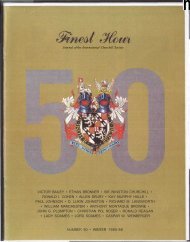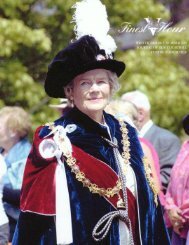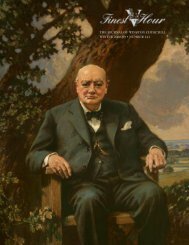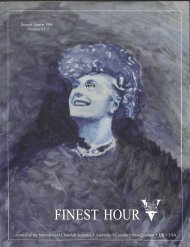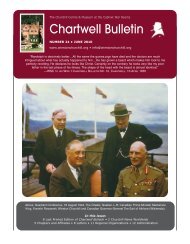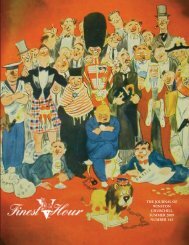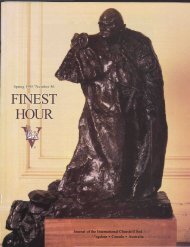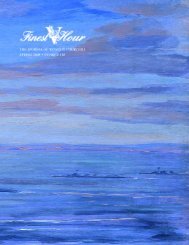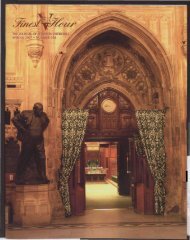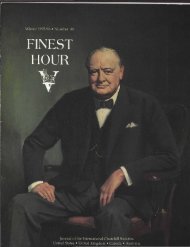International Updates - Winston Churchill
International Updates - Winston Churchill
International Updates - Winston Churchill
Create successful ePaper yourself
Turn your PDF publications into a flip-book with our unique Google optimized e-Paper software.
Overprinting omitted on bottom stamp.INDEPENDENCEill Ith NovemberQuality comparison of original f top) and forged Binda overprints.<strong>Churchill</strong>ophilately:The Rhodesia ForgeriesI 7 3 •"RHODESIAThe Nefarious WaresThe most valuable regular <strong>Churchill</strong>issue is Rhodesia's 1965 commemorativeoverprinted for the Unilateral Declarationof Independence in January 1966 (Scott#222, SG #373). Of 436,000 original<strong>Churchill</strong>s, only 20,000 were overprinted.Scarcity and value potential (US price ispresently SI25) led to a series of forgeriesof this and other UDI overprints by oneAlexander Binda, who was convicted inSalisbury of forging official governmentmaterial.Binda obtained the assistance of aformer employee of the original stampprinter (Messrs. Mardon Printers Pvt.Ltd.), and a printer in a nearby town.They obtained the actual type from Mardon's,using it on numerous sheets ofOverprint on reverse of <strong>Churchill</strong> stampand out of alignment.stamps bought from the Post Office insuch a way as to make the stamps philatelicallyunique-by either printing onthe gummed side or fading or omittingparts of the impressions on parts ofsheets. In some instances the printing wasinverted or set out-of-register.As the original type had been used,these forgeries were difficult to detect.Fortunately, Binda's nefarious activitieswere confined to making defective overprints,which are easily identifiable. Anyoverprinted stamp which is patentlydefective should therefore be regardedas suspect. All the stamps exhibited inCourt were confiscated, but it is possiblethat some copies of the forgeries arestill extant. To protect the public the. ^ jOverprinting. In normal printing registrationwould be in identical positions.Double bars omitted.Court expressed the wish that details ofthe forgeries be published. It is hopedthat the illustrations here will assist inthis regard. It is of course possible thatother varieties may exist which werenot exhibited at the trial, but sufficientexamples of the forgeries have been givento illustrate the techniques employed.It should be noted that a small numberof printing defects did occur with thegenuine stamps —such as the droppingof a spacer bar, offsets, and doubleoverprinting.A sheet of 5/ <strong>Churchill</strong>double overprints is known to exist. Twosheets with out-of-register overprints arealso known to have been inadvertentlysold by the Post Office. The print qualityis of a high standard, and no variationoccurred between the relative positionsof the overprints.Any overprint with letters or figuresmissing, missing printing at the top ofthe stamp, "fades" or printing on theback of a stamp, can with confidence beregarded as a forgery.Where such stamps are produced onFDCs bearing the date of issue (17 January1966), this should not confuse theexaminer. Binda was able to have thesecancellations "arranged" through a friendin the Post Office.-R.C. Smith, FCIS, FCWA, PS, M. Inst.
Space bar dropped between 11th andNovember.ICS Cover #20 Available Free to Members; •""• INDEPENOEN* ' 11th NoYtmb: RH^KIAJBBattle, ol ElFORTIETH ANNIVERSARY • 4 NOVEMBER 1942us:ircENTS\-?'£?s^NDEPE^:DE^;" "^' . i__ 1955,..RHODESIAjBI"A blight gtvm hoi caught the. hz&nzti o$ ouA ioldi&u,and uxvunzd and chewed all OUA kzoAti."—1HSCINTERNATIONAL CHURCHILL SOCIETYof Alexander Bin dalth of November instead of 11thNovember.Our latest cover marks the 40th Anniversary of the Battle ofEl Alamein, turning point of the war, on 4 November 1982.Franked with the USA <strong>Churchill</strong> commemorative and postmarkedBattle Ground, Washington, the cachet incorporatesa photo of WSC viewing the Alamein position, a symbolicpalm tree, and WSC's famous quote on this historic occasion.Printing of the cachet and explanatory "stuffer"is in tropical green.Covers are free to ICS members. To order yours send a long,stamped, self-addressed envelope to Dave Marcus,221 Pewter Lane, Silver Spring, Maryland 20904.Outside USA, send the same SSAE to your Branch Director.You'll find his address listed on page 19.WSC SIGNS AN ALBUM PAGEThe photo herewith is of a page frommy collection: the 1946 Victory omnibusGreat Britain 2'/id ultramarine and 3dviolet. The latter illustrates symbols ofPeace and Reconstruction: a dove bearingan olive branch; a set square and compass;and a trowel over a brick wall.I was on protection duty with Mr.<strong>Churchill</strong> about three months when thesestamps were issued on 11 June 1946. Ofcourse I was already familiar with thefamous brick wall which he'd built inthe vegetable garden at Chartwell, andwas aware how proud he was of his bricklayingprowess. His handiwork still endures—atribute to yet another of thenumerous <strong>Churchill</strong>ian skills.On the first day of issue I bought thetwo British stamps, hinged them in thecenter of an album page and surroundedthem with a black ink line. That afternoon,36 years ago though it seems likeyesterday, I was in Mr. <strong>Churchill</strong>'s studyat 28 Hyde Park Gate. We were talkingabout a coming trip to Europe. At a suitablemoment I produced this page. "I aminterested in stamps, Sir, and today thePost Office came out with the Victoryissue."He looked at the page. I was sure hewould be interested in the trowel and thebrick wall, so I pointed out this feature."You have been described as the 'Architectof Peace'", I said. "I think it wouldbe very appropriate if you signed thissymbolic Peace issue."He reached for his fountain pen,paused, then repeated musingly, "TheArchitect of Peace ..." I don't knowwhat was in his mind but the words hadundoubtedly struck some sympatheticchord. He wrote his name above the lineI had prepared and finished his signaturewith the characteristic arrowhead. Wecontinued to discuss security plans forhis European visit. I was happy to haveengineered this unique philatelic itemand proud to add it to my <strong>Churchill</strong>ianacollection.-Ronald E. Golding
Top left: The 1965 design Wedgwood sweet dish, with more complicated laurel wreath and cigar-equipped WSC. Top right: The 1974 design has bow tie,no cigar, simpler wreath. Above left: bottom of 1965 glazed tankard. Above right: Chartwelfand Glazed tankards, both circa 1965.<strong>Churchill</strong> on WedgwoodBarlaston's Beautiful Commemorative ChinawareBY MICHAEL RICHARDSIn 1759 the first Josiah Wedgwood, FRS, founded a potterycompany at Etruria, which was succeeded by a new works atBarlaston, near Stoke-on-Trent. For over 200 years Barlastonhas attracted the finest craftsmen in Britain, many of whosefamilies have worked for Wedgwood for generations. The factoryis set in a beautiful 5 00 acre estate, and is well worth visiting.Rather than arrange factory tours, the Wedgwood Company havecreated a "crafts display" in which the huge variety of skills employedin the creation of their pottery are demonstrated on a rotatingbasis by volunteers. It is a splendid sight, and well worth adetour to the Stoke-in-Trent area when you are in the vicinity.Our knowledge of <strong>Churchill</strong> Wedgwood is unfortunatelyincomplete, because we have-not been able to document everypiece by press time. Whether any likeness of Sir <strong>Winston</strong> wasused on Wedgwood prior to 1965 is not, therefore, known. TheGreat Man's death inspired the first issue, his Birth Centenaryin 1974 the second.The most familiar type of <strong>Churchill</strong> Wedgwood is of coursethe famous blue jasperware, a rough-finish material best knownfor its white basalt designs taken from Greek sculpture.Identifying the 1965 vintage <strong>Churchill</strong> jasper from the 1974 isa simple matter. The former uses a bust of WSC with the butt ofa cigar and a conventional necktie; the latter bust shows no cigarand shifts to the more typical bow tie. The 1965 designs alsoemploy a somewhat more intricate pattern of laurel leaves andberries for the borders. Unfortunately Wedgwood do not appearto have "got it all together" by combining the cigar with thebow tie!The following is a checklist of <strong>Churchill</strong> Wedgwood known todate. We would be glad to hear from members as to additions to •this list, which in final form will appear in the ICS <strong>Churchill</strong>Collectors Handbook.10
Sweet Dish (1965 & 1974): Issued in both pale blue andblack jasper with hand-applied white bas-relief cameo of <strong>Churchill</strong>and laurel border, diameter 4Y2". The more common blue varietysells for roughly $20 (£11.50), while the black variety is 50percent more expensive. In both cases, the 1965 design is therarer.Glazed Tankard (1965): One of the rarer pieces, thishandsome piece measures 4V4" high with a 3Yi" diameter at top.The "cigar-type" bas-relief of WSC is accompanied by a lionrampant on the opposite side, both in white against a bluebackground. Along the bottom in black is the quote "... Giveus the tools and we will finish the job," from WSC's broadcastreplyto Roosevelt's "Sail on, O Ship of State" message in 1941.On the under side is an inaccurate quote from 1940: "... Wewill fight on the seas and oceans. We shall fight on the beaches.We shall fight on the landing grounds, in the fields, in the streetsand in the hills—We shall never surrender." We can set no exactvalue on this piece, but are informed that examples are notexpensive at $100 (£57). There was also a limited edition ofthis tankard, carrying a number.Chart well Tankard (1965): Measuring 4V-i" high with a 3V2"diameter top and bottom, this large glazed tankard illustratesthe Karsh-based portrait of WSC on a dark blue background withthe southern elevation of Chartwell against dark blue and greenbackgrounds. On the bottom is a facsimile signature of WSCand a note about Chartwell, erroneously giving 1927-65 as theyears of <strong>Churchill</strong>'s occupation. (It was actually 1922-65). Notas rare as the glazed blue tankard, this item should commandabout $50 (£28) on the current market. Quantity unknown.<strong>Churchill</strong> Bust (1974): A very fine bust modeled by ArnoldMachin, OBE, RA, was created in limited edition of 750 in blackbasalt. Each bust was numbered and inscribed in gold, andsupplied with a numbered certificate. Height 6%". A merehandful of these are being offered by the <strong>Churchill</strong> Memorial inFulton, Missouri, priced at $185 (less 10% for Friends of theMemorial) plus shipping. This is one of the finest small sculpturesof WSC and would seem to be reasonably valued at present.Portrait Medallion (1974): Noted by Wedgwood as pale blueand white Jasper, this has also been reported in black and white.A limited edition of 1000, the medallion was inscribed in goldon the reverse and individually numbered, then clay framed,pierced and slotted for hanging. Accompanied by a numberedcertificate, the medallions measure 4V4 x 4V4". Value about $25today.Jasper Cameo Tankard (1974): We have not seen this item.Wedgwood's brochure describes it as a "hand made TopazTankard bearing a black and white Jasper cameo of Sir <strong>Winston</strong><strong>Churchill</strong>." The edition was limited to 750, and the height was3V4". Each piece was accompanied by a numbered certificate.<strong>Churchill</strong> Plate (1974): This 6V2" diameter commemorativeplate was issued in large quantities (exact numbers unknown).There were two versions: a plain black basalt plate with raisedrelief portrait of WSC; and the same item complete with a goldinscription: "<strong>Winston</strong> <strong>Churchill</strong>, 1974-1965-Author, Statesman,Soldier, Artist." The pieces bear a special gold backstamp. Valueabout $25 for the plain, $35 for the gold.<strong>Churchill</strong> Miniatures (1974): Small 1" oval replicas of theportrait medallion were also produced for the Centenary,apparently in large quantity. These appear to have been issuedonly .in blue and white jasper as tie tacs, cufflinks and pendants.Machin Bust (1974): The most ambitious Wedgwood <strong>Churchill</strong>commemorative piece is a foot-high version of the smallerMachin, gold inscribed. We have seen few of them, but it istruly a work of art. Price is appropriate, around £1000.According to Ivan Hiller of British Collectibles, "The 1974commemorative of the centenary birth of Sir <strong>Winston</strong> <strong>Churchill</strong>proved to be a major flop with collectors because of its almosttotal irrelevance. Therefore one can still find many pieces stillunsold at the original issue price in British ceramic stores."The editors would be pleased to hear about additions to thislist. For a future article, we should also be particularly glad toreceive descriptions of toby jugs, which appear to be legion.BY ROBIN LAMPSONThe book is closed—the last page written, signed,But here it stands, for us to read forever;And we who seek to praise it only findOur words but candles to his sunlight—clever,Perhaps, beside his wisdom, wit and heady-Eloquence, his magnificent endeavor.What can we say of him who has alreadySpoken, himself, all the superlatives? —Whose mighty heart itself beat out the steadyRhythm of history, and whose valor givesA greater human lustre to the ages—Now, for all time, as long as freedom lives,Wherever man with tyranny engages,Courage will leap to him from this book's pages.The late Robin Lampson was born in California when the memoryof the Forty-niners was still fresh. He fashioned some of the bestprose and poetry to come out of the Golden State, LAUGHTEROUT OF THE GROUND (Scribners, 1935J being perhaps his bestknown work. A longtime member of ICS, Mr. Lampson wrote thisterza-rima sonnet on the day of Sir <strong>Winston</strong>'s death. This is thesecond time it has seen publication. The first was in FH #19.11
Action This DayAUTUMN 1882: AGE 8With Lord Randolph's illness in a remission stage, he wasactive in the campaign against dual control of the ConservativeParty by Salisbury in the Lords and Northcote in the Commons.In December he rested on the Riviera and in Algiers. Jennieremained in London, having contacted what was eventually diagnosedas typhoid.<strong>Winston</strong>, meanwhile, had been enrolled in St. George's Schoolat Ascot. Although he wrote his parents that "I am very happyat school," he later recalled (in MY EARLY LIFE, Woods A37)"how I hated this school ..." He certainly made little progress.In his first term report in December he placed last in his class.His parents were informed that <strong>Winston</strong> was "a regular pickle"who must treat his work far more seriously.This unhappy period was presaged by <strong>Winston</strong>'s rather unpleasantexperience the first day he met his Form Master. Hewas asked to learn the declensions of mensa, the Latin wordfor "table." When he had the temerity to ask the meaning anduse of the vocative case, he was told he would use it when addressinga table. "But I never do," he replied. He was then sternlyinformed: "If you are impertinent, you will be punished, andpunished, let me tell you, very severely."Thus began what he called a "hateful servitude" and a distastefor the classics "from which, I have been told, many of ourcleverest men have derived so much solace and profit." He<strong>Winston</strong> clearly did not enjoy this experience. Seeing no reasonto ever use strange tongues, he never learned to write a Latinverse. Nor did he accomplish any Greek, except for the alphabet.He was deemed a very naughty boy, and was among the schoolleaders only in receiving birchings. At St. George's, these wereadministered with a harshness that was singular—even for theVictorian Age.AUTUMN 1907: AGE 33After observing French Army maneuvers in September,<strong>Churchill</strong> traveled through Italy to Vienna, Syracuse and Malta,where he was "installed in much state" in the palace of the GrandMasters of the Knights of Malta. Then the cruiser Venus wasplaced at his disposal for travel to Cyprus and Africa.From Nairobi, he traveled north, partly on the Nile, visitingOmdurman where he'd fought 12 years before, and Khartoum,where his manservant Scrivings died suddenly of food poisoning.This startled WSC, who realized "... how easily it might havebeen me."Though thousands of miles from home, <strong>Churchill</strong> never leftthe limelight. Punch published an article, "<strong>Winston</strong> Day By Day,"and colleagues followed his journey in the press. He kept intouch with his mother and brother Jack, and inundated theColonial Office with correspondence, much to the chagrin ofpermanent undersecretary Sir Francis Hopwood, who warnedLord Elgin: "<strong>Churchill</strong> is most troublesome . . . and will I fear givetrouble as his father did." (London would have been more upsetif it had known that WSC, as he wrote confidentially to Jennie,was involved in a plan to extend the jurisdiction of the Empirewithout consulting Elgin.) He also was permitted to write directlyto King Edward VII about his experiences.An offer from Strand Magazine for five articles brought him£750, and the £500 for book rights to MY AFRICAN JOURNEY(Woods A12)—a widely read account of his experiences—resultedin an unexpected profit from the expedition.On his return to London, <strong>Churchill</strong> was guest of honor at an18 January 1908 dinner of the National Liberal Club, which heharangued skillfully and at great length. His topic was ostensiblyhis African journey, and the prospects for Britain's vast newdominions in East Africa. But in reality his speech signified hisreturn to the domestic political wars, into which he plungedwith happy vigor.BY JOHN PLUMPTONAUTUMN 1932: AGE 58<strong>Churchill</strong> used his convalescence at Chartwell to continuework on MARLBOROUGH, with the aid of Maurice Ashley. Buta recurrence of paratyphoid occasioned a severe hemorrhageand hospitalization. Although the illness prevented active participationagainst the Government's India policy, his hostility wasinfluential and Party leaders were concerned.While still midway through MARLBOROUGH, he contracted"to undertake to write A HISTORY OF THE ENGLISH-SPEAK-ING PEOPLES, their origins, their quarrels, their misfortunes andtheir reconciliation." This was not to see publication until the1950s, but with this contract, GREAT CONTEMPORARIES(Woods A43a), and numerous magazine and newspaper articles,<strong>Churchill</strong>'s literary activities occupied his time and energies(and provided him with a substantial income.)Meanwhile, Hitler was gaining a grip on Germany, which wasinsisting on the right to rearm despite the Treaty of Versailles.In articles and speeches, <strong>Churchill</strong> challenged the German demand.Shocked by the sympathy Germany received in Britain, hepointed out that every concession was followed by a fresh demand.He warned about "all these bands of sturdy Teutonicyouths . . . with the light of desire in their eyes to suffer for theFatherland ..."<strong>Churchill</strong>'s differences with the leadership of the ConservativeParty were increasing. The National Government was lookingfor ways to disarm; WSC demanded increased powers of selfdefense—particularlyin the Royal Air Force. But his warningswere seen as alarmist and much of the public and press was outof sympathy with him.In England the Oxford Union voted "that this House refusesin any circumstances to fight for King and Country." In Germany,Adolf Hitler became Chancellor. The Union would soonfind the sincerity of its resolution sorely tested.AUTUMN 1957: AGE 83Since his retirement, Sir <strong>Winston</strong>'s way of life had changedconsiderably, but he still went to bed rather late and remainedthere until lunch time. He was greatly interested in newspaperarticles and books about himself.During the summer, Beaverbrook had told him that "therewill be a tremendous literature about you. There will be many,many volumes." Replied WSC, "That is easily understood. Iwrote about 40 myself." This production was unabated even inretirement, the most notable example being the publication ofthe third volume in A HISTORY OF THE ENGLISH-SPEAKINGPEOPLES, entitled THE AGE OF REVOLUTION.Since Lord Moran published none of his entries for this period,we can deduce that WSC was in reasonably good health. However,this was not a good time for Clemmie. She spent a week in hospitalfor a minor foot operation and had recurring attacks of influenza.Time was spent shuttling between Hyde Park Gate andChartwell. Christmas and New Year's were celebrated at Chartwell;then preparations were made to finish out the winter inthe south of France.<strong>Churchill</strong> continued as M. P. for Woodford, although he rarelymade speeches in his constituency. Any Parliamentary questionson behalf of his constituents were raised by the ConservativeMember from the neighboring constituency. Lady <strong>Churchill</strong>continued her role of attending constituency functions. Sir <strong>Winston</strong>did, however, address the Inter-Parliamentary Union Conferenceat Geneva. He told this meeting that the success of theBritish Parliamentary system was due to the fact that "in thefiercest clash of debates we have jealously guarded the right ofevery Member freely to speak for his constituents and for himself..." He continued to paint, if occasionally, and beganfinalizing galleys for THE GREAT DEMOCRACIES, last volumeof the HISTORY.12
•Ri|l||^||BY PETER SLUYS'6^Send your questions to Peter Sluys, 93Forest Av., Pearl River NY 10965 USA.Q_: How many exams did WSC need topass into Sandhurst?A: He failed the entrance exams twice,passed on his third try, but scored toolow for the infantry, as Lord Randolphhad desired, and settled for cavalry.Q: WSC ranked as Col. in World War I.T>id he ever use the title?A: As far as we can discover, no. He was,however, referred to as "Colonel <strong>Churchill</strong>1 " in The Daily Mirror of 9 March1916, reporting WSC's disastrous campaignfor the return of Lord Fisher asFirst Sea Lord. Also, WSC used the pseudonym"Colonel Warden" during WW2as a code-name when he wished to keephis own name out of the headlines —asnoted in the excellent book, THE WARAND COL. WARDEN, by Gerald Pawle.Q: Can you supply any details about thevessel Sir <strong>Winston</strong> <strong>Churchill</strong>, shown onBermuda Scott #340 and British VirginIslands Scott #241-2?A: She was a steel hulled twin-screwtraining schooner, designed by Camper &Nicholson, Southampton, built by RichardDunston, owned by the Sail Training Association,London, and registered at Hull.Tonnage was 218.4 gross, 34.6 net;measurements 135' o.a., 103' at the waterline.Her maiden voyage was from Portsmouthon 29 March 1966. Named by Mrs.June Goodson, wife of the chairman ofthe S.T.A., the ship was dedicated by theBishop of Hull. Her maiden voyage wasto Dover, Dartmouth and French ports.She was the British entry in the 1966Tall Ships Race, and had an all-girl crewin the 1972 competition. Despite heavyweather, during which a staysail carriedaway, she finished that race. She alsoparticipated in Op-Sail during the U.S.Bicentennial in 1976.— Arthur Mears, St. Stephen, N.B.Q: A pre-Woods bibliography says WSCpublished a book entitled RISINGS ONTHE NORTH-WEST FRONTIER beforeMALAKAND FIELD FORCE, Woods Al.Is this right?A: Woods and others since have attemptedto uncover this volume, but it appears tobe apocryphal. MALAKAND is Number#1.Q: Did WSC ever visit India after hissoldiering days?A: No. He considered a holiday therejust before World War II started, and wasassured by a friend of Ghandi's that hewould be welcomed (he had by then acceptedthe idea of Commonwealth statusfor India). But he never got round to it.Too busy!Q: Is there a book listing all of WSC'spaintings?A: Yes, but it's out of print. Check yourantiquarian booksellers for CHURCHILL:HIS PAINTINGS, edited by Coombs,Hamish Hamilton & World Publishing,1967. This is a fine, large format worklisting 502 of the supposed 518 <strong>Churchill</strong>paintings, illustrating them all, with manyin well executed four-color.Q: The Liberia 1965 <strong>Churchill</strong> issue includesone value showing WSC "in Admiral'sUniform" according to Scott. Whatis the uniform, and what is the lighthouse?The number is Scott #433.A: Lord Warden and Admiral of theCinque Ports (see FH #20), where WSCwas installed on 14 August 1946. There ismore gold on the cuffs and cocked hatthan on a straight-Admiral's uniform. Thelighthouse appears to be Belle Taub nearDover, whose white cliffs are visible inthe illustration, as Belle Taub is round,as in the stamp. Our. earlier guess wasSouth Foreland light, but this is a squarestructure. Thanks for this information toDon Gary and the Lighthouses StudyUnit, ATA.Philatelic illustrations of WSC in the. World WarI period are uncommon, and we often look fora ftttropriate "CR" labels to round out coverageof this period. One of the most spectacularlabels we've uncovered lately came from the1X71 Shop, Drawer E, South l.yon, Michigan'18178, for $2.50. The label, by Townsend &Sorts, Exeter, conveyed "business us usual despitethe (Servians. A set of two was issued:'"•'I'lji- ,ltul re,I.COMING UP IN FH #38:This photo of JVS andWSC reminds us that we 11feature a major piece on thePotsdam Conference —how therevisionists see it. how wesee it. And. an article on<strong>Churchill</strong> medals/coins. Andmore:Stamps: Section I of ourall-new, updated, illustratedchecklist of WSC stamps; C-Rstamps Part 4; Davaar Islandand its locals: Greek Enosis.Rooks: SAVROl.A, WSC'sonly novel reviewed, plus theusual unusual books aboutWSC. And: how to build aninexpensive WSC library.Plus: IMMORTAL WORDSand AS OTHERS SA W HIM.
Book ReviewsBY PETER J. MclVER, RICHARD M. LANGWORTH,H. ASHLEY REDBURN AND JOHN DAVID MARSHALLMARTIN GILBERT: SPOT-ON AGAIN•'<strong>Churchill</strong>/The Wilderness Years" by Martin Gilbert, Houghton-Mifflin 1982, $14.95 from <strong>Churchill</strong> Book Club (see page 17).We had a great deal of doubt about this one. Advance wordfrom England was that WILDERNESS YEARS was another spinofffrom the official biography, culled out to digestible 278-pageform for the masses. We are pleased to tell you that it is anythingbut that. It is a scholarly work in the best Gilbert tradition, accompaniedby numerous photographs not found in the officialbiography, well indexed, and able to provide what the o.b. doesnot: a rapid education on any important political event surroundingWSC's sojourn from the citadels of power. Its main purpose,of course, is to complement the WILDERNESS series on MasterpieceTheatre in early 1983. But we recommend it for the shelfof graduate <strong>Churchill</strong>ophiles because it provides excellent summaryof this crucial decade, new photographs and quick-referenceat a low price. And we love the dust jacket.Richard M. l.angwarthTWIN TRIUMPHS BY THE LADY SOAMES"Clementine <strong>Churchill</strong>" by Mary Soaines, Houghton-Mifflin1979, $14.50 postpaid from <strong>Churchill</strong>iana Co., 4629 SunsetDrive, Sacramento, CA 95S22."Family Alburn/A Personal Selection From Four Generationsof<strong>Churchill</strong>s" by Mary Soatnes, $19.50 from C.B.C. (see p. 1 7.)This reviewer should begin by admitting to serious prejudice,which influenced his judgment: he thinks Lady Soames is, toborrow a piece of Georgia vernacular, a peach. But the most criticalreviewer would be hardpressed to complain about CLEMEN-TINE CHURCHILL, a tour de force in a class by itself; or abouther sequel, FAMILY ALBUM, just released by the same publishers.Both books are in their way "standard works," mandatoryfor any <strong>Churchill</strong> bookshelf, and so far ahead of similar works asto be incomparable.CLEMENTINE CHURCHILL is of course the second "Clemmie"biography, but Fishman's MY DARLING CLEMENTINEwas justifiably criticized as a potboiler. Perhaps this has to dowith the fact that CSC was still alive when Fishman wrote itandCSC was a very private person. Her daughter Mary undertooka really authoritative biography on the understanding that itwould not be published in Lady <strong>Churchill</strong>'s lifetime.All that aside, it is a tremendous, inspiring story, a love storyfirst and foremost, for the wonderful relationship between Sir<strong>Winston</strong> and Clementine must be labeled thus; yet is is also a professional,well researched, competent history, with Clemmie'sfaults not expunged from the record, though they were overwhelminglyexceeded by her virtues.Lady <strong>Churchill</strong> was, of course, first and foremost, the perfectmate and foil for her complex genius-husband: "Clementine hadno hobbies, such as gardening —that great solace and refuge forcountless Englishwomen. For her it was more a matter of administration-notan absorbing or satisfying occupation; and her ownactive involvement stopped after deadheading roses and irises.Nor did tapestry, knitting or embroidery . . . appeal to her . . . shehad lost the habit of driving lalong with its) blissful measure ofindependence . . . Throughout her married life, Clementine's firstpriority had been to run her home. Her standards of perfectionnever altered, nor her attention to minute detail."The great strain of being Mrs. <strong>Churchill</strong>, the recurrent grapplingwith what WSC called the Black Dog-depression-followingthe Dardanelles, Plug Street, the loss of office in 1929, thebittersweet Thirties, the 1945 election, the 1955 retirement, areall measured here, and one gets the impression that each took itstoll on Clementine. But the real lady is here loo: the determinedloyalist, the closet radical, the saviour of social occasions otherwiselikely to be <strong>Winston</strong>-monologues, with that all-pervadinginterest in those around her. No one can know without readingthis book the true greatness of Lady <strong>Churchill</strong>, nor appreciatethe crucial role she played in delivering, unsullied by events, anebullient <strong>Winston</strong>, time after time, crisis after crisis, to inspire andennoble the world.Lady Soames has now rewarded us again with another epicwork of high value to <strong>Churchill</strong>ophiles. FAMILY ALBUM isunquestionably one of the three best photo-documentaries in averitable sea of the things. (The other two are Randolph <strong>Churchill</strong>'s1955 effort, CHURCHILL/HIS LIFE IN PHOTOGRAPHS,and Martin Gilbert's more recent CHURCHILL/A PHOTO-GRAPHIC PORTRAIT). One expects this to be so. A familymember is possibly the only person left who could add newphotographic history to the <strong>Churchill</strong> saga. Most photos in thepublic domain have been used so many times that to publishthem again seems somehow careless. Lady Soames, with fewexceptions (and these are needed for continuity), has no truckwith old chestnuts. There are over 400 photographs in this beautifullydesigned book, and the acknowledgements indicate that noordinary picture library could have produced them. The largestentries in the credits are Lady Soames herself, the BaronessSpencer <strong>Churchill</strong> Collection, and the Historical NewspaperCollection of ICS member John Frost.Together they provide a heartwarming and personal glimpseof the <strong>Churchill</strong>s from Jennie and Randolph to Sir <strong>Winston</strong>'sgrandchildren. There is an infant snap of WSC which I think predatesany published previously (WSC, perhaps anticipating Karsh,is not smiling); there are marvelous photos of young Jack and hisbrother and their wives and children; of Sunny Marlborough andhis Duchess Consuelo, of Clementine from babyhood up; of thehomes the <strong>Churchill</strong>s lived in or frequented;of notes between CSCand WSC, adorned with the now legendary pug dogs and pussy kats;of the <strong>Churchill</strong> children, and their children's children; of friends,colleagues and enemies, at work and at play. Lady Soames invokesonce again in photographic memory of those wonderful yet terrifyingyears, from the placid age of Victoria and Edward VII tothe slaughter of Armageddon, the fervent hopes that followedVersailles, the sombre warnings, the new plunge into disaster, thebrave, new, but ever so worrisome world that dawned in 1945,the prospects for which harry us still. All are connected by long14
narrative captions, accurately researched, and grouped into tenindividual sections from 1874 through 1967. This is more thanjust a picture book: reading it thoroughly, and digesting thesemarvelous photographs fully, will take the reader a good weekof evenings. But to paraphrase Sir <strong>Winston</strong>, the journey will beinteresting and well worth the taking more than once.I think what strikes me most in FAMILY ALBUM is the tremendousspan of time through which <strong>Winston</strong> and Clementine<strong>Churchill</strong> lived. We have been told over and over how they wereborn in an era that knew not telephones or automobiles, and departedin an age that had seen satellites in space and man rushingtoward the moon. But it is a hard and intangible concept whenyou read about it in cold type. FAMILY ALBUM makes it allcome alive with tremendous, nay violent impact. To this extentit is more than a book: it is an experience.—Richard M. LangworthWINSTON AS RUNNING DOG"<strong>Winston</strong> <strong>Churchill</strong>" by V. C. Trukhanovsky, Progress Publishers,Moscow, 1978. $9 postpaid from <strong>Churchill</strong>iana Company, 4629Sunset Drive, Sacramento CA 95822.In 1941 <strong>Churchill</strong> brought the house down in Congress withthe rhetorical query, "What kind of people do they think we are?"He referred, of course, to the Axis, but doubtless he had occasionlater to wonder the same about the Russians. This book wouldhave told him. He would not have liked it.Trukhanovsky, a Marxist historian who has written extensivelyon British history, presents a <strong>Churchill</strong> not always recognizeable.The view is interesting, and a boon to understanding the Sovietmind. The author repeats the charge of duplicity in the Hessaffair; he believes that had Hess not insisted on WSC's ouster asprelude to an Anglo-German rapprochement, Britain and Germanywould have combined against Russia. Further to this theoryhe accuses Sir William Stephenson ("Intrepid"), of planting falsedocuments to make the Germans think Stalin was about to attackthem, forcing Hitler to attack first. But it's not all old propaganda:there is some new as well. We are told that though WSC was formost of his life a very wealthy man (???), he used tax avoidanceschemes to cheat the tax man and thus the people. WSC's booksfostered the idea that Britain, not Russia, won the war; the Battleof Britain gets short shrift, as a "diversion" which helped theSoviets gain the upper hand in the East. Not discussed are theconsequences of a British defeat. Where would the USSR havebeen without the British convoys in 1941-42? Though WSC'slove of freedom seems above challenge, Trukhanovsky makes anattempt. Against the 20th Century struggle for liberation, hesays, WSC did all he could to stop the USSR from liberating thepeoples of Eastern Europe. He actually sent troops to halt theliberation of Greece. He supported Tito against the liberatingRed Army. He objected to the Hungarian put-down of 1956 andfought socialism's rise in England. Etc., etc., etc.While I cannot recommend this volume as an unerring purveyorof fact, I will at least call it an important addition to ourreferences from behind the Iron Curtain. It is biased, sometimescomical, often historically inept, and designed to promote theSoviet view. Whereas here in the West, truth has many faces, inthe Soviet Union she has only one. And that's official.-Peter J. MelverWINSTON AS ACTION MAN!"<strong>Churchill</strong>/Young Man in a Hurry 1874-1915" by Ted Morgan,Simon & Schuster, 1982. $22.95 (available at discount: see p. 1 7.)The first biography of <strong>Winston</strong> S. <strong>Churchill</strong>, WINSTONCHURCHILL: THE WAR TO DATE by Arthur Scaife, waspublished in 1900 when WSC was 26 years old. The most recentaddition by Ted Morgan, the former Sanche de Gramont, appears17 years after WSC's death. The <strong>Churchill</strong> story remains a fascinatingone, however many times it is told. And it has been told agoodly number of times. Concentrating on what many considerthe most exciting, action packed period of <strong>Churchill</strong>'s life, Morganchronicles the subject's unhappy childhood and unspectacularschool years; his service as soldier and war correspondent in India,Cuba, the Sudan and South Africa; his election to Parliament; and<strong>Churchill</strong>'s performances in all his offices from undersecretary ofstate for the colonies (1906-1908) to Chancellor of the Duchy ofLancaster (1915). There is heavy concentration on the Admiralty,and the failure of the Dardanelles.Chronicling all this and much, much more, Ted Morgan providesa well-rounded and candid account of the first 41 years ofthe life—public and private —of one of the most complex, colorfuland charismatic personalities of this or any other century.Morgan's CHURCHILL should appeal to both specialist andgeneralist. The general reader will find that Morgan skillfullycombines narrative and interpretation with readability. The academicianshould be more than satisfied with Morgan's documentation.There are 1476 unobtrusive footnotes which reveal thevariety of primary and secondary sources consulted. From thisfact one should not conclude that Morgan's biography is footnotorious.It is not.This reviewer eagerly awaits the completion of Morgan's portraitof what might be the last great man of the Western world.-John David MarshallExcerpted with permission from The Tennessean SundayBookcase, page 10F, 18 July 1982.Editor's note: Devoted bibliophiles who have not yet readMorgan's book may be interested in my impressions from readingit in tandem with the highly comparable CHURCHILL/HERI-TAGE AND ADVENTURE 1874-1911, published in 1961 byPeter de Mendelssohn. This was to have been followed by twomore volumes, but the author never published. Mr. Morgananswered my (and John David's) hope that his own sequel wasunderway with the thought that he was perhaps more willingthan his publisher-so YOUNG MAN IN A HURRY may not,much to our regret, be the first of a series.Through 1911, it is illuminating to read each episode inWSC's career alternately in de Mendelssohn and Morgan. Thereis no doubt at all that Morgan's is the more gripping, dramatic,and far more daring work. The possible parentage of two prominentfigures in the <strong>Churchill</strong> story is discussed, though to mymind not adequately documented —de Mendelssohn in 1961carefully avoided such controversy. Morgan is also far moreauthoritative, despite a higher word-count-per-episode providedby de Mendelssohn. The latter, after all, did not have at his disposalthe marvelous Companion Volumes of the official biography,which Morgan acknowledges in his preface. In sum,Morgan's is by far the better book: more skillfully written (iftoo closely paralleling the earlier work on occasion, even downto the same quotes, which are perhaps unavoidable), more exciting,a far "easier read," and accompanied by better illustrations,not a few of them new. To me, Ted Morgan has revealed more ofthe private <strong>Churchill</strong> than any other biographer to date. This isimmensely valuable. It is a stunning portrait which reveals WSC"warts and all," yet it left me respecting the Great Man all themore. continued overleaf -RML15
<strong>Churchill</strong> in Context:The Nuclear Freeze & ArgentinaBY RICHARD M. LANGWORTHWINSTON CHURCHILL saw the potential horrors of the nuclear age much earlier than most. Writing in 1924 he warned us: "Withouthaving improved appreciably in virtue or enjoying wiser guidance, [mankind] has got into its hands for the first time the tools bywhich it can unfailingly accomplish its own extermination . . . Death stands at attention, obedient, expectant, ready to serve, ready toshear away the peoples en masse; ready, if called on, to pulverize, without hope of repair, what is left of civilisation. He awaits onlythe word of command. He awaits it from a frail, bewildered being, long his victim, now — for one occasion only —his Master."<strong>Churchill</strong> also feared nuclear proliferation. "'It may well be," he said in 1946, "that in a few years this awful agency of destructionwill be widespread, and the catastrophe following from its use by several warring nations will not only bring to an end all that we callcivilisation, but may possibly disintegrate the globe itself." 2But Sir <strong>Winston</strong> was also a realist. Whenever I hear someone advocate a nuclear freeze-and someone always does these days-1reply as I think WSC might: "You are quite right; now, what is the first step?" This invariably reveals the proponent as (a) a unilateraldisarmer or (b) a mouther of platitudes who has not looked beyond the slogans for the substance. It is rarely necessary to add that a"freeze" is the official position of the USSR-yet when 100 Russians turned out at the same date as a half million Americans to demonstratefor it, the Russians were jailed.Another old chestnut of the freeze movement is that "both sides have enough bombs to destroy each other many times over." Touse the Left's own rhetoric, this is a simplistic argument. The problem is not the quantity of bombs, but the unrelenting improvementin the technology of delivery systems and defenses. The loss of HMS Sheffield off the Falklands last Spring, due to her lack of thelatest anti-missle defenses, demonstrated the danger, even to a superior power, of failing to accomodate modern technology.We may, 1 think, safely conclude that the Great Man would oppose the freeze movement-not through lack of horror for the bomb,but out of his famous respect for history. He would implore us not to ignore the mistakes of the past. <strong>Churchill</strong> had faced well-meaningdisarmers before, as for example in March 1938 . . ."I have watched this famous island descending incontinently, fecklessly, the stairway which leads to a dark gulf. It is a fine, broadstairway at the beginning, but after a bit the carpet ends. A little farther on there are only flagstones, and a little farther on still thesebreak beneath your feet ... If mortal catastrophe should ever overtake the British Nation and the British Empire, historians a thousandyears hence . . . will never understand how it was that a victorious nation, with everything in hand, suffered themselves to bebrought low, and to cast away all that they had gained by measureless sacrifice . . . " 3Sir <strong>Winston</strong> advanced an argument that has never been answered by today's advocates of a nuclear freeze: that the bomb is ironicallyan agent of peace: "These fearful scientific discoveries cast their shadow on every thoughtful mind. But nevertheless I believethat we are justified in feeling that there has been a diminution of tension and that the probabilities of another world war have dimin-Book Reviews, continuedBATTLE OF THE PACHYDERMS"<strong>Churchill</strong> and de Gaulle," by Francois Kersaudy, Collins/Londonand Atheneum/New York, 1981. £12.95 in Britain, $19.95in USA. Presently out of print in USA according to Atheneum.This is the first book on the WSC-de Gaulle relationship andI can best commend it by hoping that Dr. Kersuady will satisfy uswith a much-needed sequel on Roosevelt and de Gaulle, whoserelations are only partly covered here. John Buchan says in hisCROMWELL, "Great men throw upon posterity the obligationof understanding them." Inevitably we have to rely on historiansand biographers for the knowledge on which to base such understanding.Thus, a main duty of a biographer is to enable his subjectto be seen as he was, rather than to interpret him for us. Thebiographer must be accurate and impartial and base his work onthorough research. On these counts Kersaudy succeeds extraordinarilywell. He corrects the memories of both men in theirown writings and is particularly severe on de Gaulle's L'UNITE,L'APPEL and MEMOIRS. His work lacks both bias and chauvanism,and his English is of such high quality that one might thinkhe was writing in his native tongue.Kersaudy details the enormous stresses which de Gaulle callouslyimposed on a desperate Prime Minister, which transformed<strong>Churchill</strong>'s initial friendship into a state of near-enmity. Bothmen loved France passionately, and at times blindly: only oneloved England. It was a misfortune that de Gaulle did not haveClemenceau's perception of <strong>Churchill</strong>'s enduring attachment toFrance, and that this cultured General remained so prejudiced.The events immediately prior to D-Day and afterward provideone of the most absorbing chapters, and give point to the lessonto be drawn from the story. The author shows how de Gaulleknew he had gained the support of the British press and publicopinion, and did not hesitate to use this strength. He recognizedthe diminishing British role after American entry into the war,and sensed the demise of British-but not French —imperialpower. De Gaulle himself admitted that he could have done littlewithout <strong>Churchill</strong>'s help. It was <strong>Churchill</strong> alone who pressed atYalta for a French zone of occupation in Germany. Only <strong>Churchill</strong>defended and spoke up for the French at Potsdam.De Gaulle did not carry <strong>Churchill</strong>'s awesome responsibilities,was not subject to Parliamentary scrutiny nor answerable to anation-and at that, a nation alone for two years. He did nothave to deal with mighty and difficult allies like Stalin, FDRand Chiang Kai-shek, nor with a host of refugee governments inLondon. One can only conclude from his conduct in Britain thatde Gaulle was developing into an astute, even ruthless politician,relentlessly in pursuit of his own political ends, consciously tormentingthe PM. In essence he was a blackmailer of the worstkind: he blackmailed a friend who had rescued and taken theexile into his own house.As Brendan Bracken would have said, "Poor, dear <strong>Winston</strong>."-H. Ashley Redburn, OBE16
The <strong>Churchill</strong> Literary TrustA Proposal for a New Kind of <strong>Churchill</strong> MemorialWE HAVE LONG DESIRED to contribute our own memorial to Sir <strong>Winston</strong>. The one thing which seems to be unattended to, in ourjudgment, is the <strong>Churchill</strong> Literary Heritage. Nearly all pre-1940 books are out-of-print. So are the COMPLETE WORKS, COMPLETEESSAYS and COMPLETE SPttLHtS. btudents, researchers, libraries are increasingly unable to acquire for research, study, referenceor syllabus-basing some of the finest written and spoken words in the English language. A CHURCHILL LITERARY TRUSTseems highly desirable. This is our preliminary proposal. We request your comments, advice and suggestions.—A NEW BIBLIOGRAPHY, accurate and illustrated, listing al1 English, American and Commonwealth editions of the works of Sir<strong>Winston</strong> is sorely needed. Six ICS members are already at work on segments of this project, including two college professors,two librarians and two bibliophiles. Estimated cost for 2500 copies of a new bibliography: $20,000.—NEW EDITIONS of out-of-print works should be undertaken, beginning with MALAKAND FIELD FORCE—not in expensive "collectorsbindings" but in facsimile form to the first edition (though MALAKAND would best use the revised Silver Library typescript.)The objective: to bring the now-unavailable or extremely expensive early works of WSC to everyone, rich and poor. Good facsimilenew editions are not expensive. Estimated cost of a MALAKAND reprint, S20,000.—COMPLETE WORKS should be assembled from existing works and reprints for libraries and institutions in need. Estimated costof assembling 1000 sets of complete works using various editions, and reprinting all out-of-print titles: $500,000.—PAMPHLETS. Opportunities exist to pamphletize specialized studies of <strong>Churchill</strong>'s life and times, and to republish in pamphletform unpublished manuscripts (like THE DREAM) or long-out-of-print essays (like MAN OVERBOARD). These should be published anddistributed on a regular basis. Estimated cost for 20 pamphlets over five years: $30,000.—BOOK DISTRIBUTION. The trust should be set up to receive bequests of <strong>Churchill</strong> books and distribute them to needful librariesand institutions, so that the efforts of donors—involving thousands of hours and great expense—shall not be squandered. Estimatedcosts of storage, cataloguing, secretarial aid and shipping for five years of operation: $20,000.—SYLLABUS. Westminster College's syllabus on <strong>Churchill</strong>, and others like it, should be brought to the attention of otherinstitutes of higher learning for course construction or reference, particularly in the teaching of English and modern history.Estimated costs of publishing and promoting such syllabuses to liberal arts institutions worldwide: $5000.—A CHURCHILL CONCORDANCE, referencing the written and spoken words of Sir <strong>Winston</strong> is the single most important goal we forsee.Nothing like it exists—something like it is vital. Computer technology now allows this to be assembled, either in publishedor program form, for much less than previously contemplated, with telephone link-up for instant retrieval of referencesto any subject, keyed to every edition of every <strong>Churchill</strong> book'. Est. cost of programming and setting up: $200,000.ICS ALREADY HAS the talent among its members to begin the more modest steps in this program. What we need now is (1) a.serious discussion among members, patron and honorary members as to whether these goals are vitally needed, whether anyoneelse is already engaged in them, and (2) assistance in organiging a Trust and planning for its funding. The latter is not asdaunting as it sounds. But we must first PROVE the need and DEMONSTRATE our ability to deliver.Please comment to your Branch Director or to ICS, P0 Box 385, Contoocook, New Hampshire 03229 USA.SOUND FILM: "A Nation's Homage" by Rank, 1st edition, 8 or 16mm, in color. All leads appreciated.Geoffrey J. Wheeler, 88A Franklin Avenue, Tadley, Basingstoke, RG26 6EU, England.POSTCARDS: Any illustrating WSC. Betty Sowel 1 , 5433 Drakes Court, Byron, California 94514 USA.COVER ICS #10a, Anniversary of WSC's last visit to Commons, 2nd version, 29 July 74 with Westminster stampand House of Commons postmark. Richard Stevenson, 563 Greenwich Avenue, Paulsboro, New Jersey 08066 USA.1 -ternsFINEST HOUR BACK ISSUES: #1-13, $2ea/5 for $9 (some xeroxed); #14-36, $3ea/5 for $13.ACTION THIS DAY ST[CKERS: Indentical in size & typeface to WSC's famous World War II labels, very close inCS color, gummed. Perfect for IRS refund requests! Pad of 100, $3 postpaid. Two pads $5.50 postpaid.LIBRARY CREDO 8x10" parchment with WSC silhouette and the quote, "BOOKS in all their variety are often the means by whichcivilization may be carried triumphantly forward." Donated by John David Marshall. $2.50 postpaid. Very frameable!CHURCHILL MAX I-CARD Lovely 5x7" Art Craft card showing WSC, raised facsimile autograph, with USA <strong>Churchill</strong> stamp cancelled for<strong>Churchill</strong> Memorial Dedication, 7 May 1969. Donated by Arthur Davidson of Westminster College. Supply limited! $5 postpaid.ICS COVERS See FINEST HOUR #36 for list. Numbers #3/5/7/8/9/10/1 la/12/12a/l 3/1 5/17 are still available.TO ORDER: Your personal cheque in your country's currency. US price shown above. GREAT BRITAJN: divide by 1.7 forsterling equivalent. CANADA: multiply by 1.2. AUSTRALIA: same as USA; NEW ZEALAND: multiply by 1.3. Outside North America, adda reasonable small amount for airmail. SEND TO ICS, Herb Tishfield, 3 Selma Court, East Northport, New York 11731 USA.AuctionLot 1 ;Lot 2Lot 3Lot 4Lot 5To bid: Send postcard with lot number and your bid to George Lewis, 268 Canterbury Road, Westfield NJ 07090.(PI ease bid in US dollars; if you win you may pay in your home currency Increments are 50c to S10, $1 from$10 to $50, $5 over $50. To sel 1 : Pack carefully, send to George with full description £ reserve price.LORD RANDOLPH CHURCHILL, 1st English Edn, 2 Vols, VG condition, RESERVE $85 ILot 6: NEMON BUST of WSC, Alvastone,MARLB0R0UGH, 5 of 6 1st American Edns + 1-Vol Abridged Edn to complete, RESERVE $35 (1974), 8" high, nice, RESERVE $110WHILE ENGLAND SLEPT, 1st Am Edn, VG, si. spine fade, o/w fine, RESERVE $35Lot 7: EDUADOR 1965 MNH,RESERVE $3THE SECOND WORLD WAR, 6 Vols, Book Club Editions, six sets available, bid $15 ONLY Lot 8: NICARAGUA 19^5 FDR, RES. $5CHURCHILL/COMPLETE SPEECHES (8 Vols, 8917 pages, 18" shelf space), RESERVE $175Lot 9: ALBANIA FDR/WSC labels(8) $5We need more items for the auction. ICS charges 10% commission, but welcomes donated items too. Please help!18
VOTETheICS CONSTITUTION (to be published for your ratification in FH #38) provides nine elective 4-yearBoard seats and six appointive 2-year seats, proportional to member percentage in the USA(8) , CANADA(2), BRITAIN (2), AUSTRALIA (2) and NEW ZEALAND (1). The elected members will elect 1983-84 officersand the new Chairman will logically appoint runners-up to the six appointive seats. 'TO VOTE: Send a postcard to your ICS branch (see addresses below). Please vote for director(s)in your country..UNITED STATES (Vote for 5): Postcards to Sue M. Hefner, 134 N. Woodlawn, Lima, Ohio 45805 (5 4-year £ 3 2-year terms open)W. GLEN BROWNE, Calif.: FH Philatelic Editor, Editor of <strong>Churchill</strong> Stamp Checklist to begin in FH38. Member since 1969.. SUE M. HEFNER, Ohio: ICS Secretary, compiler of FH's forthcoming index, officer since the early 1970s, member since 1969.RICHARD M. LANGWORTH, N.H.: ICS Chairman, Editor of FH, founder of the original Study Unit, I983 tour host, member since 196. GEORGE A. LEWIS, N.J.: ICS Treasurer, ICS Auction Manager, bibliophile, member since 1974.DAVID MARCUS, Virginia: ICS Covers Manager, FH staff ("Covering the Covers"), philatelist, member since 1969.KEN PHILLIPS, Oklahoma: ICS Public Relations Manager, former editor <strong>Churchill</strong> Study Unit Bulletin, member since I98O.CANADA (Vote for one): Postcards to ICS, 20 Burbank Drive, Willowdale, Ontario M2K 1M8 (one 4-year & one 2-year terms open)RONALD W. DOWNEY, Vancouver: Founder <strong>Winston</strong> <strong>Churchill</strong> Society, longtime officer thereof, member of ICS since 1982.GEORGE E. TEMPLE, Toronto: ICS-Canadian Director, member of present board, bibliophile & collector, ICS member since 1981.GREAT BRITAIN (Vote for one). Postcards to ICS, 88A Franklin Av, Tadley, Basingstoke, Hants. RG26 6EU (one 4-year, one 2-year). PETER J. MclVER, Nuneaton: ICS UK Press Officer, active Young Conservatives, FH contributor, ICS member since 1973.GEOFFREY J. WHEELER, Basingstoke: ICS-British Director for 1983-84, active Lions Club, ICS member since circa 1974.AUSTRALIA (Vote for one). Postcards to 8 Regnans Avenue, Endeavour Hills, Victoria 3802 (one 4-year & one 2-year terms open)RONALD E. GOLDING, Sydney: Former detective to WSC 1946-7, FH contributor, 1983 tour host, ICS member since 1981.PETER M. JENKINS, Victoria: Present ICS-Australian Director, active in Australian recruitment, philatelist, member since 197!§y ZEALAND S ELSEWHERE Mat Newland is running unopposed in N.Z. N.Z. and other members may vote in any one of the aboveBranch elections. Please send an airmail postcard to the appropriate address.BRONZE SCULPTURE by William McVey, creator of the Washington Statue of WSC (FH36).#1 Three-dimensional mask (14x9x6") based on Washingston statue, unmounted, $365.#2 As above, mounted on laminated board (illustrated at right), $410#3 Relief "mask", 18" diameter circular background, all bronze, $175All prices postpaid, including packing and a small mark-up for ICS. There is noorder. Send your cheque to William McVey, 18 Pepper Ridge Rd, Cleveland, Ohio 44124.ClassifiedjaRAMAPHONE RECORDS (78 rpm) : "In a Solemn Hour," "The War of the Unknown Warriors", "Every Man to HisPost" Woods #D(c)122/124/125, six discs in all, good condition. The collection, $150 from BertramRota Ltd., 30-31 Long Acre, London WC2E 9LT, England, Tel. (01) 836-O723. Contact: George Lawson..PHOTOGRAPHS of WSC and other 20th Century statesmen, 60 <strong>Churchill</strong> pix to choose from, each priced at•>4.^5 postpaid. Selections sent on approval. Send your wants to Ray Fardy, 7 Boxwood Lane, Hicksville,New York 11801 USA. Mention periods and individuals required.•§IAMPS AND COVERS The 1982 <strong>Churchill</strong> commemorative souvenir sheet from Turks £ Caicos Islands (see' Page 4), mint unhinged $2.75, First Day Cover $7.00. Dozens of limited-edition <strong>Churchill</strong> covers and <strong>Churchill</strong> FDCs for sale°r trade. Also a good selection of <strong>Churchill</strong> commemorative issues and <strong>Churchill</strong>-related stamps for as little as St. Sendstamped self-addressed envelope to Richard Langworth, Burrage Road, Contoocook, New Hampshire 03229 USA.ilPiJNTBATTEN ON CHURCHILL Cassette recording of Lord Mountbatten' s superlative speech on WSC, covering their relationship fromT~51 •*+ until Sir <strong>Winston</strong>'s death, delivered at Edmonton, Zurich, Fulton. $10 postpaid to ICS, c/o Bill Beatty, 194 ConnorDr ive, Henrietta, New York 14467 USA. (Make your cheque payable to ICS, please).•P-HURCHILL BIRTH CENTENARY STAMP COLLECTION Includes all Scott-listed material plus carefully selected additional materialCimperfs, proofs, deluxe souvenir sheets, etc.) all mint, 0G, NH, VF or better. To be sold as one lot. For details pleasecontact F.L. Anduze, 4020 Gait Ocean Drive #1505, Fort Lauderdale, Florida 33308.J-jjURCHILL-RELATED STAMP COLLECTION Many of the stamps mentioned in my columns in FH, plus more. Totals 383 different, verycTean, all VF and either LH or NH, mounted in Showgards on White Ace <strong>Churchill</strong> pages in White Ace album with dust cover.<strong>Churchill</strong> biography typed on pages and country typed in red. Many hard to get though not expensive. 23 items catalogue over510 which are very good investments. For complete list including condition and cat. val. send 40c. Price of collection $375Postpaid, 10% going to ICS. Cat.val. $1130. Glen Browne, P0 Box 5171, Canyon Lake, California 92380 USA.•i§£^EY1974 CHURCHILL FIRST DAY COVER Cachet has 39mm bronze antique silver medal of WSC, $10 to ICS members postpaid,•^edacoin Internationa], 421 East Carson Street, Suite I89, Las Vegas, Nevada 89101 USA.JjgMON BUST OF CHURCHILL Original Alvastone mounted on 1" thick wooden pedastal , see photograph on page 11 this issue. Sellfor $125 or trade for other Churchi11iana or WSC books. R.Langworth, Burrage Road, Contoocook, New Hampshire 03229 USA.SAVROLA (Woods A3) by <strong>Winston</strong> S. <strong>Churchill</strong>. First American Edition* published before English edition, inSUperb condition, virtually as-new. Best offer over $350. Also, a special leather-bound edition of theSECOND WORLD WAR by WSC (Houghton-Miff 1 in) , 6 volumes, full black leather with fleur de lis design on board:and red leather/gold spine labels, $65 postpaid. Harland Eastman, Box 276, Springvale, Maine 04083 USA.•SjjURCHILL BOOKS: "BY" & "ABOUT" Stamped long return envelope brings my six-page list of duplicates for sale or trade. Pricesfrom $3 to $475 rare, out-of-print, mundane editions, biographies, photo documentaries, special studies, all subjects andPeople related to <strong>Churchill</strong>. Among Sir <strong>Winston</strong>'s own books, I have first editions available of SAVROLA, LONDON TO LADYSMITH,MY AFRICAN JOURNEY LIBERALISM S THE SOCIAL PROBLEM, LORD RANDOLPH CHURCHILL, THE WORLD CRISIS, MY EARLY LIFE, MARLBOROUGH,GREAT CONTEMPORARIES ARMS AND THE COVENANT, WHILE ENGLAND SLEPT, INTO BATTLE, BLOOD SWEAT £ TEARS, UNRELENTING STRUGGLE,SECOND WORLD WAR YOUNG WINSTONS WARS. Richard Langworth, Burrage Road, Contoocook, New Hampshire 03229 USA.19
"Add-On"First Day CoversI don't know how other cover collectors feel about "add-ons", but for my part, they are the highlight of a collection. I don't believethere is anything more disappointing than spending the time, effort and money to make a beautiful cachet, sending it away to becanceled on the first day of issue, and having it returned dirty and beat up. It is far better to process 10 or 20 blank covers for theF.D. cancellation, and then "add-on" cover designs to those that are returned in good shape. Pictured here are several <strong>Churchill</strong> coverswhich have been so handled. Other covers of mine appeared on the front of FHs #6 and #7.-Richard StevensonCHURCHILL4\Sir<strong>Winston</strong> <strong>Churchill</strong>*\i>British.... ^T .k STATESMANJrCHURCHIUV1965 jlie rrFMT



